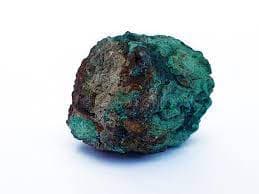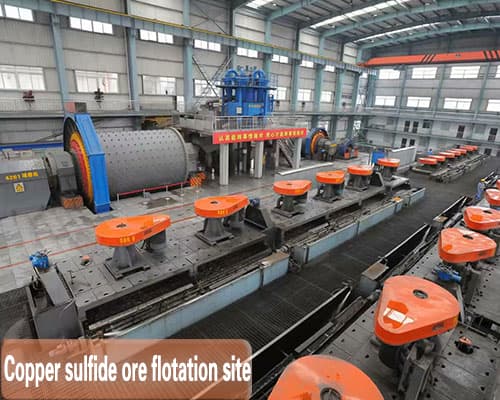Copper sulfide ore is one of the most important sources of copper resources in the world. The efficient development and utilization of copper sulfide ore resources is of great significance to ensuring the sustainable supply of copper resources in the world and in my country. With the rapid economic development, the contradiction between supply and demand of copper mines has become more and more prominent. In order to alleviate the development pressure of copper resources, the majority of beneficiation workers have carried out in-depth and careful research on low-grade, complex refractory copper sulfide ores and polymetallic ores with associated copper sulfide minerals, and achieved good results. This paper summarizes the research progress of copper sulfide ore flotation process, inhibitors and collectors.

The copper sulfide minerals mainly include chalcopyrite, chalcocite, copper indigo and bornite, among which chalcocite has the strongest effect with xanthate. Next is copper blue, then bornite, and the weakest chalcopyrite. The most common iron sulfide ores are pyrite and pyrrhotite, and understanding their properties is helpful for copper-sulfur flotation separation.
Flotation process technology
- Priority flotation. Generally, copper is floated first and then sulfur is floated. For disseminated copper-sulfur ore, a preferential flotation process is adopted, and the tailings are then floated with sulfur after the copper is floated. In order to reduce the consumption of sulfuric acid when floating sulfur and ensure safe operation, the process conditions of low alkalinity should be used as far as possible when floating copper.
- Mixing-separation flotation. It is more advantageous to use this process for copper-sulfur ore with low sulfur content in the original ore and easy-to-float copper minerals. The copper-sulfur minerals are first mixed flotation in the weak alkaline pulp, and the mixed concentrate is added with lime to separate the copper and sulfur in the high-alkaline pulp.
- Semi-preferential mixing-separation flotation. The semi-priority mixing-separation flotation uses Z-200, OSN-43, Youzhi-105, etc. with good selectivity as the collector for the semi-priority floating copper operation. Floating copper minerals that are easy to float are first floated, and some qualified copper concentrates are obtained. Then copper-sulfur mixed flotation is carried out, and the obtained copper-sulfur mixed concentrate is separated and flotated by floating copper for sulfur suppression. This method avoids the inhibition of easy-floating copper minerals under high lime dosage, and does not need to consume a large amount of sulfuric acid to activate pyrite.
While the graded flotation process improves the product grade and recovery rate, it adopts a differentiated operation process for the flotation of different particle sizes. It makes the flotation operation process more targeted, and the total dosage of ore chemicals per ton of sulfur selection system is greatly reduced. For example, in the transformation of a copper mine’s classification flotation sulfur process, the copper tailings were subjected to secondary classification treatment and divided into +0.037mm, 0.025-0.037mm, and -0.025mm. According to the characteristics of many clay minerals in the original ore, it is necessary to desliming and de-sliming the copper tailings. Due to the enrichment of sulfur in the classification process, the -0.025mm particle size product has a low sulfur grade, and at the same time, this grade of product contains more sludge and useless chemicals, and the yield is low. Therefore, the tail is directly discarded, and the final products entering the flotation process are two grades of +0.037mm and 0.025-0.037mm, to achieve graded flotation.

Beneficiation inhibitor
The main copper ore resources in my country are chalcopyrite, which generally has the characteristics of less rich ore and difficult dressing and more low-grade ore. And with the continuous exploitation and utilization of high-quality copper ore resources, the selected grade of copper ore gradually decreases. In order to meet the demand for copper in economic development, efficient utilization of copper-bearing tailings resources is an effective method. In most copper-bearing tailings, pyrite and copper sulfide coexist densely. In order to obtain copper concentrates that meet smelting requirements, copper-sulfur separation must be carried out.
The content of potassium dicarboxylate is more than 99%, belonging to inorganic salts or inorganic substances, orange-red triclinic crystals, slightly soluble in water, easily soluble in hot water, the aqueous solution is acidic, it is an effective inhibitor of galena. Potassium dicarboxylate is a strong oxidant in an acidic medium; it generates acid ions in weakly alkaline pulp, which will oxidize the surface of galena to PbSO4. The formation of insoluble and hydrophilic PbCrO4 film, so that galena is inhibited. In order to promote the inhibition of potassium dimethacrylate, the slurry needs to be stirred for a long time (30 min), and the pH value of the slurry is kept in the range of 7.4 – 8. In the separation and flotation of polymetallic sulfide ores, potassium dicarboxylate is mainly used to separate copper and lead mixed concentrates, inhibit lead minerals, and flotation copper minerals, which is one of the most commonly used methods for copper and lead separation.
Beneficiation collector
The flotation agent is one of the most important factors in the flotation process. It can be used to change and adjust the floatability of minerals and improve the properties of bubbles in a large range, so as to achieve the purpose of controlling the separation of minerals. The collector is characterized by a solid group usually composed of divalent sulfur atoms inside the molecule, and the molecular weight of the hydrophobic group is small. It has the effect of collecting sulfide minerals, but not gangue minerals such as quartz and calcite. Its main representatives are xanthate, black medicine, aminothioformate, mercaptan, thionine and their corresponding intoxicants.
Xanthate is the most commonly used collector for flotation of chalcopyrite. High-grade xanthate is suitable for collecting sulfide ores that are difficult to float, while ethyl xanthate belongs to low-grade xanthate. Its selectivity is good, which is conducive to improving the concentrate grade, but the recovery rate control is relatively poor. Butyl xanthate belongs to high-grade xanthate, which is beneficial to improve the metal recovery rate, but because of its strong collecting ability. His selectivity is relatively weak, and may sometimes affect the concentrate grade. In order to adapt to the inhomogeneity of the mineral surface and improve its selectivity in production, xanthate with different length carbon chains is often mixed, and good results can be obtained.
With the rapid development of my country’s economy, the demand for copper-sulfur ore will gradually increase, and the rational development and utilization of limited mineral resources will be an arduous task. With the continuous mining of mineral resources, there are more and more complex and refractory copper-zinc ores. In the production process, the mine is also constantly exploring the use of the process of firstly classifying desliming and removing chemicals and then selecting sulfur, so that the grade and recovery rate of sulfur concentrate have been improved. In addition, new mineral processing agents should be actively developed to improve mineral processing efficiency.
